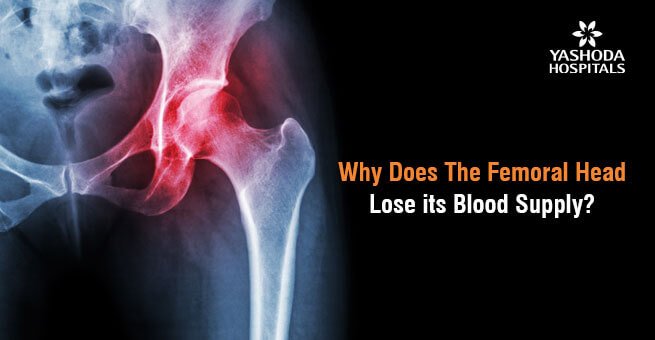How Is A Hip Bone That Has Lost Blood Circulation Repaired
Why does the femoral head loose its blood supply?

What is Avascular Necrosis or Osteonecrosis?
A lack of blood supply to the tissue within the bone leads to its death called Avascular necrosis or Osteonecrosis. Information technology tin sometimes lead to tiny breaks inside the structure of the bone and somewhen its collapse. The hip is the nearly unremarkably affected surface area with osteonecrosis. Other than the hip, ordinarily affected areas are the genu, shoulder, hand and foot.
What are the symptoms of Avascular Necrosis?
The early stages of avascular necrosis may non exist associated with whatever symptoms. However, the affected joint may begin to hurt as the condition progresses and the person puts on weight in the affected surface area. The principal symptom of avascular necrosis is pain which develops gradually and can be mild or severe. Sometimes the pain may persist even on lying down. The pain is located at the centre of the groin or radiates to the area of the thigh or buttock. In sure persons, (4 to 5 out of 10) avascular necrosis may be bilateral, i.due east., it develops on both hip joints.

What are the causes of Avascular Necrosis?
Osteonecrosis normally affects people between the ages of 25 and 50. The primary cause of avascular necrosis is the interruption of blood supply within the bone which can be caused by:
- Trauma or injury to a joint or bone: A traumatic injury similar an accident or a condition like a dislocated articulation tin obliterate the adjacent blood vessels.
- Obstacle in claret vessels due to fatty deposits: The small-scale-sized blood vessels inside the bone can get blocked due to the fat deposits (lipids) which can obstruct the blood supply to the bones.
- Sure medical conditions: Blood menstruation to the bone can too become macerated in certain conditions like Gaucher'due south disease and sickle cell anaemia. In certain cases, radiations therapy for the treatment of cancers may as well pb to harm to the blood vessels and weakening of the bones.
- Unknown causes: In about 1-fourth of cases diagnosed with avascular necrosis, the cause of interrupted blood flow may remain uncertain.
What are the hazard factors for developing Avascular Necrosis?
Many factors can increment the likelihood of avascular necrosis such as:
- Injuries or Trauma that reduce blood menstruation to bones due to obliteration of feeding blood vessels.
- Use of medications like steroid utilise: High-dose corticosteroids used for the management of sure medical conditions like SLE, rheumatological conditions, ALL, multiple sclerosis etc. tin lead to avascular necrosis probably by increasing the levels of lipid inside the blood, thereby reducing blood menstruum.
- Booze excess: Excessive consumption of alcoholic drinks for a prolonged duration of time can also cause fat deposits to class in the blood vessels, thereby increasing the tendency for obliteration.
- Use of medications like bisphosphonates: Prolonged use of medications similar bisphosphonates that help in increasing the density of bones in osteoporosis, multiple myeloma and metastatic breast cancer etc may besides contribute to developing osteonecrosis of the jaw as a rare complication.
- Sure medical procedures: Cancer therapy with radiations and organ transplantation like kidney transplant are also known to be associated with avascular necrosis.
Some of the medical weather condition that increase an private's susceptibility to avascular necrosis include:
- Diabetes
- HIV/AIDS
- Pancreatitis
- Sickle cell anaemia
- Systemic lupus erythematosus
- Gaucher's disease
What are the investigations needed for diagnosis?
The diagnosis of avascular necrosis is performed by an Orthopaedic Surgeon based on medical history, physical examination and tests. Tenderness and movements may be assessed by pressing around the joints and moving them during physical examination.
Imaging tests: Advised to make up one's mind the source of pain
- 10-rays: Decide the os changes in the later stages of avascular necrosis.
- MRI: Appraise the presence of early on changes in bone indicative of avascular necrosis.

What are the stages of Avascular Necrosis?
There are normally four stages of avascular necrosis.
Stage I: Progress from a normal, healthy hip to pain observed in the groin surface area
Stage 2: Pain and stiffness
Stage III: Pain radiates to the surrounding areas similar the knee joint
Phase IV: Hurting and limp on the afflicted side

What are the treatment options for Avascular Necrosis?
The goal of treatment in avascular necrosis is to manage the symptoms and prevent further bone loss. Sometimes, the condition may exist self-limiting and can be managed conservatively. The treatment is a combination of conservative and surgical direction when required.
- Medications like pain killers and Osteoporosis medication
- Weight begetting off the joint with crutches for avascular necrosis of femoral head
- Physiotherapy and hip exercises
- Lifestyle modifications to foreclose excessive alcohol consumption or handling of alcohol dependence
Surgical options: Since the symptoms of osteonecrosis develop mostly when the condition has progressed far, the orthopaedic surgeon might recommend surgery. The unremarkably done surgical procedures include:
- Core decompression
- Core decompression and Bone Marrow Aspirate Concentrate (BMAC) insertion
- Total hip replacement
What complications tin can occur in untreated Avascular Necrosis?
Avascular necrosis is progressive in nature. If left untreated, information technology deteriorates with time and eventually, the bone may collapse. Progressive avascular necrosis also leads to loss of the smooth surfaces of the thereby causing severe arthritis.
What is Cadre Decompression?
In this procedure, the afflicted part of the femoral caput is drilled to relieve pain and pressure level in the bone. This could provide pain relief and prevent rapid progression to arthritis in select patients when at that place is no subchondral fracture/ collapse of the caput.
What is Core Decompression with BMAC insertion?
In this procedure, the afflicted bone is drilled and bone marrow aspiration from Iliac crest (pelvic os) is taken and centrifuged in a auto. This concentrate is injected into the drilled hole in the os to assist in new bone germination to strengthen the afflicted os.
What are the dissimilar types of hip replacements?
The dissimilar types of hip replacements available include:
- Cemented Full Hip Replacement: The prosthesis is fixed in the bone with os cement that acts like grout.
- Uncemented Full Hip Replacement: The prosthesis has a porous coating or hydroxyapatite coating that helps in achieving fixation in the bone.
- Hybrid Full Hip Replacement: Information technology is the combination of the uncemented cup and cemented stem.
- Reverse Hybrid Total Hip replacement: It is the combination of the cemented cup and uncemented stem.
What are the different begetting options in Total Hip Replacement?
The unlike bearing options in Total Hip Replacement include:
- Ceramic – on – Ceramic
- Ceramic – on – Polyethylene
- Metal – on – Polyethylene
Which begetting surface lasts longer?
The Metal-on-Polyethylene has been the gold standard for a long elapsing. Withal, long term (>20 years) results of Ceramic bearings appear to be promising. Ceramic-on-Ceramic and Ceramic-on-Polyethylene has demonstrated to exist functioning well at twenty years of follow-upwardly studies.
References:
- Avascular necrosis, MayoClinic, https://world wide web.mayoclinic.org/diseases-weather/avascular-necrosis/symptoms-causes/syc-20369859. Accessed on 10th November 2020.
- Femoral Caput Avascular Necrosis, Medscape, https://emedicine.medscape.com/commodity/86568-overview. Accessed on 10th Nov 2020
- Avascular Necrosis (AVN or Osteonecrosis), WebMD, https://www.webmd.com/arthritis/avascular-necrosis-osteonecrosis-symptoms-treatments. Accessed on 11th November 2020
- Femoral Caput Avascular Necrosis, NCBI, https://www.ncbi.nlm.nih.gov/books/NBK546658/#. Accessed on 11th November 2020
Almost Author –
Dr. Praveen Mereddy, Consultant joint Replacement & Trauma Surgeon, Yashoda Hospitals – Hyderabad
MS (Ortho), DNB (Ortho), MRCS (Ed), G.Ch (Ortho), FRCS (Ortho)
Complex Chief Hip and Knee Replacement Surgery, Partial Knee Replacement Surgery, Treatment of Painful/Unstable/Failed (Loosening/infection) Primary Joint Replacements, Complex, complicated fractures and Pelvi-acetabular trauma

MS (Ortho), DNB (Ortho), MRCS (Ed), Yard.Ch (Ortho), FRCS (Ortho)
Consultant Joint Replacement & Trauma Surgeon
Source: https://www.yashodahospitals.com/blog/why-does-the-femoral-head-loose-its-blood-supply/
Posted by: edensthinty.blogspot.com


0 Response to "How Is A Hip Bone That Has Lost Blood Circulation Repaired"
Post a Comment